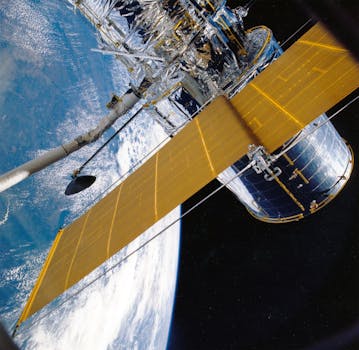
From Ground to Sky: The Evolution of Satellite Telecommunications Technology
Satellite Telecommunications
The evolution of satellite telecommunications technology has revolutionized the way we communicate, from its humble beginnings to the current state of advanced satellite systems. Satellite telecommunications have come a long way since the launch of the first commercial communications satellite, Intelsat 1, in 1965. This satellite was capable of transmitting signals across the Atlantic Ocean, marking the beginning of a new era in global communications. Today, satellite telecommunications play a vital role in providing internet access, telecommunications services, and broadcasting to remote and underserved areas around the world.
The early days of satellite telecommunications were marked by limited capacity and high costs. However, with advancements in technology, satellite systems have become more efficient, reliable, and cost-effective. The introduction of geostationary satellites, which orbit the Earth at an altitude of approximately 36,000 kilometers, has enabled the provision of continuous coverage over a specific region. This has led to the widespread adoption of satellite telecommunications for various applications, including television broadcasting, telecommunications, and navigation.
Advancements in Satellite Technology
Over the years, significant advancements have been made in satellite technology, leading to improved performance, increased capacity, and reduced costs. Some of the key developments include the introduction of reusable launch vehicles, advanced propulsion systems, and high-throughput satellites. Reusable launch vehicles have significantly reduced the cost of launching satellites into orbit, making it more affordable for companies to deploy satellite constellations. Advanced propulsion systems have enabled satellites to maintain their position and altitude more efficiently, reducing the need for frequent adjustments.
High-throughput satellites, such as those using Ka-band and Q/V-band frequencies, offer higher data rates and greater capacity than traditional satellites. These satellites use advanced technologies, including phased arrays and beam-forming, to provide multiple, narrowly focused beams, increasing the overall capacity and reducing interference. The development of smaller, more efficient satellites, such as nano-satellites and micro-satellites, has also opened up new opportunities for satellite telecommunications. These smaller satellites are cheaper to launch and can be used for a variety of applications, including Earth observation, communications, and scientific research.
Current State of Satellite Telecommunications
Today, satellite telecommunications play a vital role in providing global communications, particularly in areas where terrestrial infrastructure is limited or non-existent. Satellite systems are used for a wide range of applications, including broadband internet access, mobile communications, navigation, and broadcasting. The increasing demand for satellite capacity has led to the development of new satellite constellations, such as OneWeb and Starlink, which aim to provide global coverage and high-speed internet access.
The current state of satellite telecommunications is characterized by the use of advanced technologies, including 5G, artificial intelligence, and the Internet of Things (IoT). The integration of these technologies is expected to further enhance the capabilities of satellite systems, enabling new applications and services, such as smart cities, autonomous vehicles, and precision agriculture. Furthermore, the development of new satellite frequencies, such as terahertz and millimeter waves, is expected to provide even higher data rates and greater capacity, supporting the growing demand for satellite telecommunications.
Future of Satellite Telecommunications
The future of satellite telecommunications holds much promise, with ongoing advancements in technology and the development of new applications and services. The increasing use of satellite systems for Earth observation, navigation, and communications is expected to drive growth in the satellite industry. The integration of satellite technologies with other technologies, such as 5G and IoT, is expected to enable new use cases and applications, such as smart cities, autonomous vehicles, and precision agriculture.
However, the future of satellite telecommunications also poses significant challenges, including the need for sustainable and responsible use of space, the management of orbital debris, and the development of regulations and standards for the industry. The growth of the satellite industry must be balanced with the need to protect the environment and ensure the long-term sustainability of space activities.
In conclusion, the evolution of satellite telecommunications technology has come a long way since the launch of the first commercial communications satellite in 1965. From its humble beginnings to the current state of advanced satellite systems, satellite telecommunications have revolutionized the way we communicate, providing global coverage and high-speed internet access. As the industry continues to evolve, it is essential to address the challenges and opportunities ahead, ensuring the sustainable and responsible use of space for the benefit of humanity.




